Almost every artist, at some point, draws inspiration from photographs. Many artists capture their own photos specifically to translate them into paintings, while others occasionally use images sourced from social media or various websites as photo references. It’s common in art classes to see students create stunning paintings from provided photo references, eager to share their masterpieces.
This is a photo I found online:
This artwork is based on the aforementioned photograph:
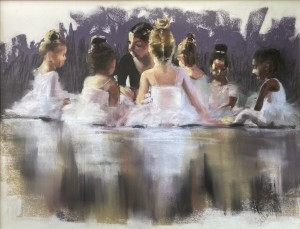 Ballet Class Pastel Painting
Ballet Class Pastel Painting
This particular painting was a demonstration piece, and the original photo was sourced from Unsplash, a platform known for offering images free for use without needing permission or paying royalties.
However, the legal implications aren’t always at the forefront of an artist’s mind. It’s easy to find oneself instinctively saving images that appeal, perhaps capturing an interesting pose or a beautiful sunset, only to later consider the source and rights.
Imagine the dedication of a photographer who spends an entire night in challenging conditions, like the Everglades marshland, battling insects and wildlife to capture the perfect sunrise shot with a traditional camera. The photograph is then proudly shared online, only to be met with a wave of paintings strikingly similar to their original image appearing across their social media feed.
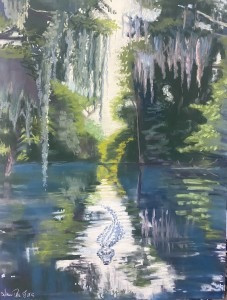 Figure Sketch Based on Imagination
Figure Sketch Based on Imagination
This figure sketch, while not directly based on a specific photograph, exemplifies the style in question. It is inspired by plein air sketches of Brooker Creek with an alligator added from imagination.
Legally, creating a painting from someone else’s photograph is permissible for personal use. You are within your rights to replicate various subjects – museum masterpieces, celebrity portraits, or even iconic photographs – for practice and personal enjoyment, protected under free speech. However, exhibiting or selling such works without permission steps into the realm of infringing on the original artist’s intellectual property rights.
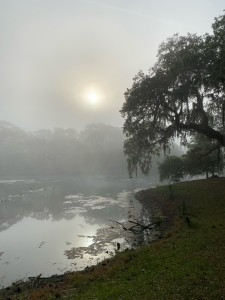 Mist and Fog Reference Photo
Mist and Fog Reference Photo
John Chestnut Park enveloped in mist, captured in a friend’s Facebook photo.
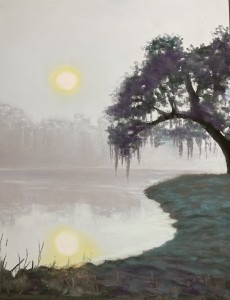 Misty Morning Pastel Interpretation My pastel interpretation of the misty morning photograph.
Misty Morning Pastel Interpretation My pastel interpretation of the misty morning photograph.
This brings up nuanced questions. For instance, would recreating a photograph in icing on a cake constitute copyright infringement? Defining intellectual property can indeed be complex.
Malcolm Gladwell, in his insightful New Yorker article on plagiarism, differentiates between transformative and derivative borrowing. Transformative borrowing involves using another’s idea as a springboard, evolving it into a distinct, original artwork. An example is creating Alice in Wonderland themed cupcakes. Even if Lewis Carroll were alive, he would lack legal grounds to object, as the cupcakes merely interpret his characters in a different medium. Conversely, writing a sequel where Alice’s brother follows her down the rabbit hole would be derivative borrowing.
Derivative work heavily relies on the original; it cannot stand alone. Take away the source material, and the derivative piece loses its foundation and meaning.
Gladwell’s essay uses Beethoven’s 5th Symphony to illustrate this point:
Ferrara then played the most famous four-note sequence in classical music, the opening of Beethoven’s Fifth: G, G, G, E-flat. This was unmistakably Beethoven. But was it original? “That’s a harder case,” Ferrara said. “Actually, though, other composers wrote that. Beethoven himself wrote that in a piano sonata, and you can find figures like that in composers who predate Beethoven. It’s one thing if you’re talking about da-da-da dummm, da-da-da dummm—those notes, with those durations. But just the four pitches, G, G, G, E-flat? Nobody owns those.”
(Note: This excerpt is reprinted here with credit to the author for illustrative purposes.)
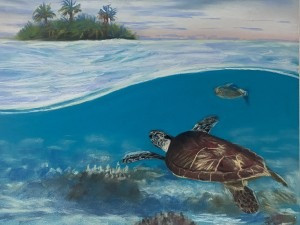 Pastel Painting Inspired by Unsplash Photo This pastel painting, titled “Journey,” is my artistic interpretation of a photo from Unsplash (the original photo has since been misplaced).
Pastel Painting Inspired by Unsplash Photo This pastel painting, titled “Journey,” is my artistic interpretation of a photo from Unsplash (the original photo has since been misplaced).
Recently, a student from my online art class considered entering a painting created in class into a group exhibition, prompting her to inquire about the reference photo’s implications for selling the artwork.
In my classes, I primarily use my own photographs but occasionally utilize images from royalty-free sites like Unsplash or iStockphoto, particularly when seeking specific subjects like a Hawksbill Sea Turtle or a unique location.
Purchasing stock photos grants specific usage rights, often for purposes like advertising or as outlined in the licensing agreement. Many platforms catering to artists encourage using their photos as painting references and invite artists to share their resulting artworks. This is the case with groups like “Landscape Artists Reference Photos” on Facebook, from which I’ve sourced images.
Upon researching the reference photo used in class, it was confirmed to be licensed through Unsplash, a free service. Without a specific contract restricting its use, technically, the student could exhibit and sell her painting without legal repercussions.
However, this leads to an ethical question: Is it morally right to sell a painting derived from someone else’s photograph? A photograph is itself a complete artwork, embodying the photographer’s composition and vision captured through the lens. Directly copying a photograph without significant interpretation or alteration can be viewed as a form of plagiarism, even if permission is granted.
The pivotal concept for artists is “transformation.” When we use an idea from another source and transform it into our unique expression, we fundamentally alter its essence.
I often draw inspiration from diverse cultural sources—magazine advertisements, newspaper photos, even works by old masters. Credit isn’t always explicitly given, especially when borrowing just an idea, such as the silhouette of a figure against a fountain or the auras around stars reminiscent of Van Gogh’s “Starry Night.” The resulting painting becomes distinct, not immediately associated with the original inspiration. This exemplifies transformative borrowing.
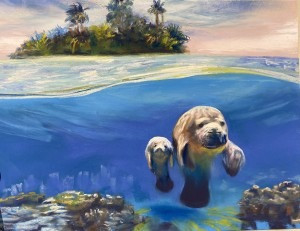 Prayer for the Manatees – Transformative Painting
Prayer for the Manatees – Transformative Painting
“Prayer for the Manatees,” inspired by a turtle photograph, showcases a more transformative approach.
Within the art world, particularly in pastel art communities, using another’s photos is generally discouraged. For instance, posting on the Pastel Society of America’s Facebook page requires stating that the work is from one’s own photo or painted from life. Works based on others’ photos, even with permission or purchased rights, are typically excluded.
This can be restrictive for artists with disabilities or those homebound, especially wildlife or pet portrait artists who rely on client-provided photos and are then limited in exhibiting their work in juried shows.
Conversely, if an artist creates a distinctive painting, like “juggling bears,” and wants to protect it from replication, copyrighting the specific artwork is possible. While the idea of “juggling bears” cannot be copyrighted, the unique depiction of three laughing, juggling bears can be. If a similar image appears in mass production, legal action is possible, particularly if the original painting was registered with the copyright office, providing stronger grounds to prove originality and infringement.
Finally, differentiating between trademark and copyright is crucial. While a series like “Surfboards on top of vans” acrylic paintings can be copyrighted as a body of work, incorporating someone else’s trademark, such as Volkswagen Vans, can lead to trademark infringement. Volkswagen successfully sued an artist for including their vehicle’s distinctive shape and logo in a painting. Trademark infringement can have significant legal consequences.
In conclusion, my online student chose to exhibit a different painting, one readily available for sale, reflecting a thoughtful and ethical decision. This instance hopefully encourages all artists to consider ethical practices in their work.
Disclaimer: Please note, I am not a legal professional, merely an artist who occasionally utilizes public domain images for painting. Consult with a copyright attorney for definitive legal advice.
